YAMAHA XVZ1300A 2000 Owner's Guide
Manufacturer: YAMAHA, Model Year: 2000, Model line: XVZ1300A, Model: YAMAHA XVZ1300A 2000Pages: 91, PDF Size: 15.45 MB
Page 31 of 91

4-1
4
EAU01114
4-PRE-OPERATION CHECKSOwners are personally responsible for their vehicle’s condition. Your motorcycle’s vital functions can start to deteriorate
quickly and unexpectedly, even if it remains unused (for instance, if it is exposed to the elements). Any damage, fluid leak or
loss of tire pressure could have serious consequences. Therefore, it is very important that, in addition to a thorough visual in-
spection, you check the following points before each ride.
EAU00340
PRE-OPERATION CHECK LIST
ITEM CHECKS PAGE
Front brake• Check operation, fluid level and vehicle for fluid leakage.
• Fill with DOT 4 brake fluid if necessary.
6-17 ~ 6-21
Rear brake• Check operation, fluid level and vehicle for fluid leakage.
• Fill with DOT 4 brake fluid if necessary.
Clutch• Check operation, fluid level and vehicle for fluid leakage.
• Fill with DOT 4 brake fluid if necessary.6-16
Throttle grip and housing• Check for smooth operation.
• Lubricate if necessary.6-12
Engine oil• Check oil level.
• Fill with oil if necessary.6-7 ~ 6-9
Coolant reservoir tank• Check coolant level.
• Fill with coolant if necessary.6-10 ~ 6-11
Final gear oil• Check vehicle for leakage. 6-10
Wheels and tires• Check tire pressure, wear and for damage. 6-13 ~ 6-16
Brake and shift pedal
shafts• Check for smooth operation.
• Lubricate if necessary.6-21
Brake and clutch lever
pivots• Check for smooth operation.
• Lubricate if necessary.6-22
Sidestand pivot• Check for smooth operation.
• Lubricate if necessary.6-22
E_4YP_Preop.fm Page 1 Wednesday, October 6, 1999 10:04 AM
Page 32 of 91
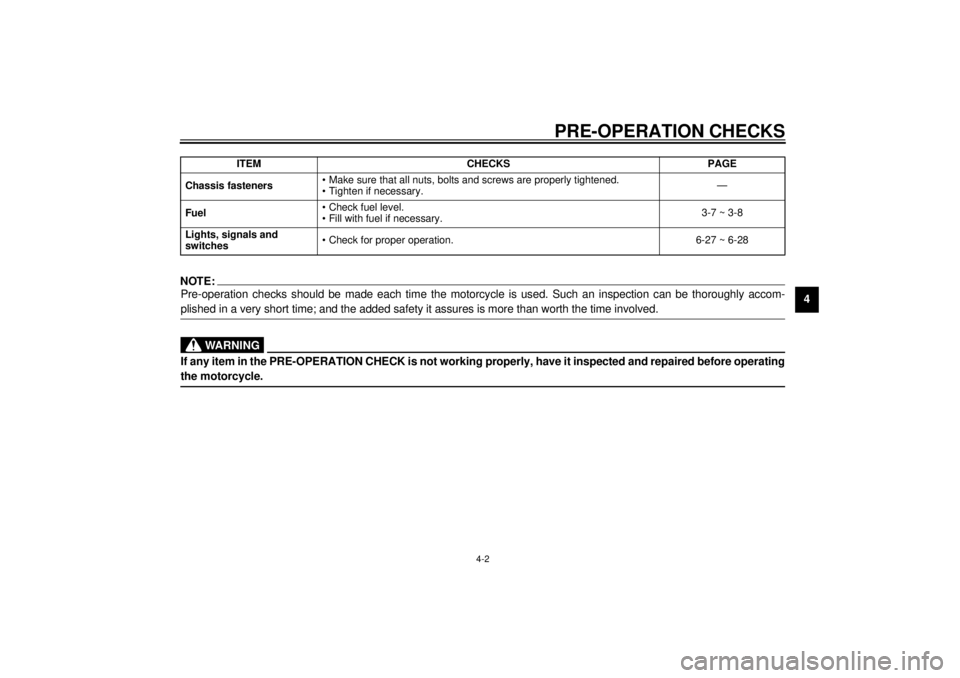
PRE-OPERATION CHECKS
4-2
4
NOTE:Pre-operation checks should be made each time the motorcycle is used. Such an inspection can be thoroughly accom-
plished in a very short time; and the added safety it assures is more than worth the time involved.
WARNING
If any item in the PRE-OPERATION CHECK is not working properly, have it inspected and repaired before operating
the motorcycle.Chassis fasteners• Make sure that all nuts, bolts and screws are properly tightened.
• Tighten if necessary.—
Fuel• Check fuel level.
• Fill with fuel if necessary.3-7 ~ 3-8
Lights, signals and
switches• Check for proper operation. 6-27 ~ 6-28 ITEM CHECKS PAGE
E_4YP_Preop.fm Page 2 Wednesday, October 6, 1999 10:04 AM
Page 33 of 91

E_4YP_Preop.fm Page 3 Wednesday, October 6, 1999 10:04 AM
Page 34 of 91
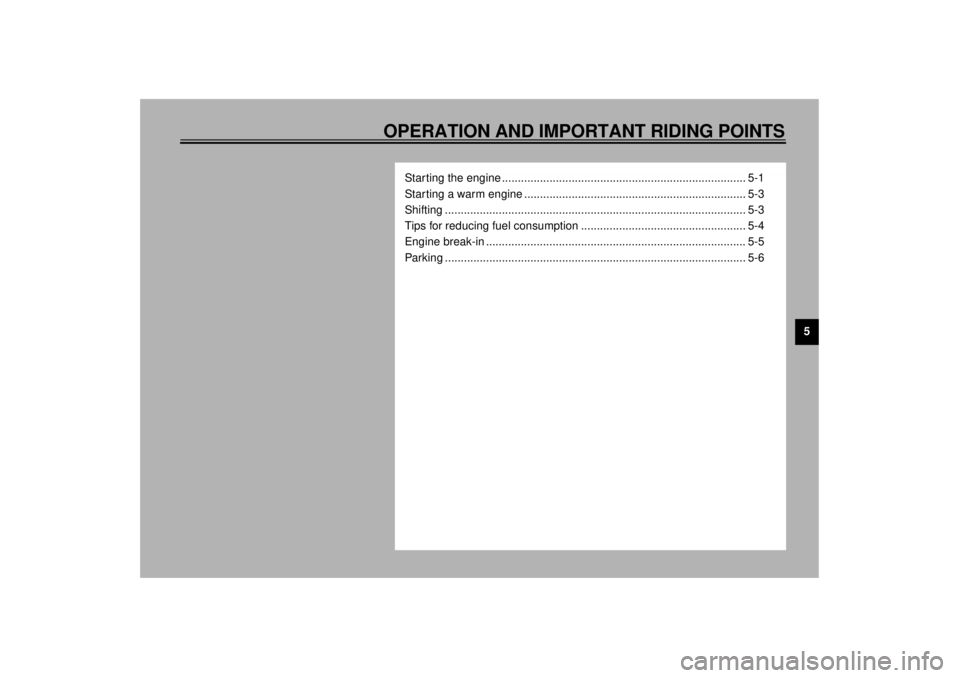
5
OPERATION AND IMPORTANT RIDING POINTS
Starting the engine ............................................................................. 5-1
Starting a warm engine ...................................................................... 5-3
Shifting ............................................................................................... 5-3
Tips for reducing fuel consumption .................................................... 5-4
Engine break-in .................................................................................. 5-5
Parking ............................................................................................... 5-6
E_4YP_OperationTOC.fm Page 1 Wednesday, October 6, 1999 10:04 AM
Page 35 of 91

5-1
5
EAU00372
5-OPERATION AND IMPORTANT RIDING POINTS
EAU00373
WARNING
@ l
Before riding this motorcycle,
become thoroughly familiar
with all operating controls and
their functions. Consult a
Yamaha dealer regarding any
control or function that you do
not thoroughly understand.
l
Never start your engine or let it
run for any length of time in a
closed area. The exhaust fumes
are poisonous and can cause
loss of consciousness and
death within a short time. Al-
ways operate your motorcycle
in an area with adequate ventila-
tion.
l
Before starting out, always be
sure the sidestand is up. Failure
to retract the sidestand com-
pletely can result in a serious
accident when you try to turn a
corner.
@
EAU01588
Starting the engineNOTE:@ This motorcycle is equipped with a
starting and an ignition circuit cut-off
switch.
The engine can be started only under
one of the following conditions:l
The transmission is in neutral.
l
The sidestand is up, the transmis-
sion is in gear, and the clutch is
disengaged.
The motorcycle must not be ridden
when the sidestand is down.
@
EW000054
WARNING
@ Before going through the following
steps, check the function of the
sidestand switch and clutch switch.
(Refer to page 3-15.) @
E_4YP_Operation.fm Page 1 Wednesday, October 6, 1999 10:05 AM
Page 36 of 91
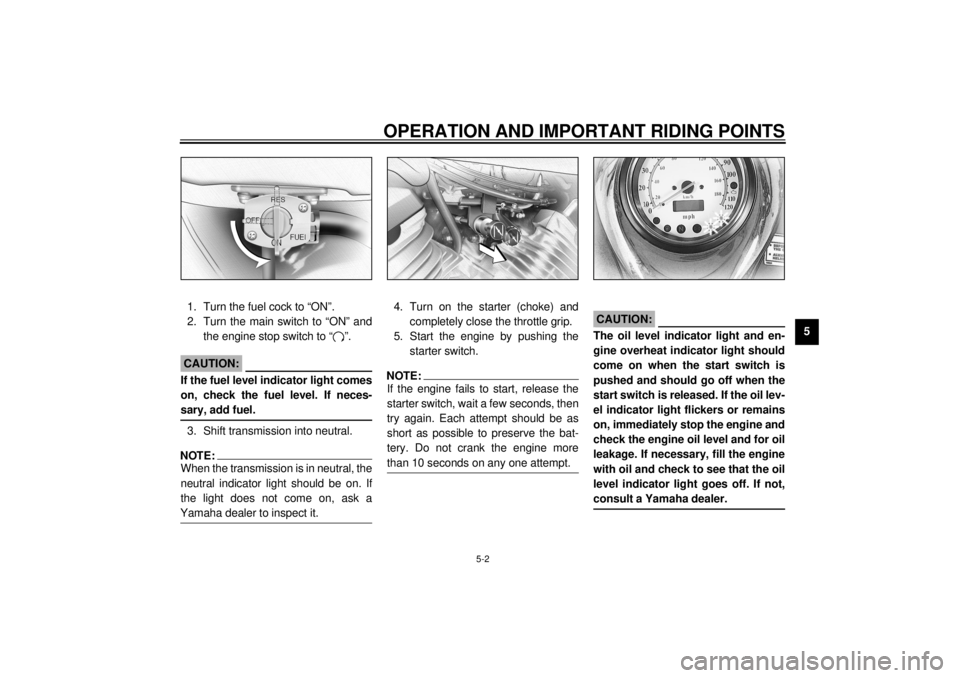
OPERATION AND IMPORTANT RIDING POINTS
5-2
5 1. Turn the fuel cock to “ON”.
2. Turn the main switch to “ON” and
the engine stop switch to “ ”.
EC000037
CAUTION:@ If the fuel level indicator light comes
on, check the fuel level. If neces-
sary, add fuel. @3. Shift transmission into neutral.NOTE:@ When the transmission is in neutral, the
neutral indicator light should be on. If
the light does not come on, ask a
Yamaha dealer to inspect it. @
4. Turn on the starter (choke) and
completely close the throttle grip.
5. Start the engine by pushing the
starter switch.NOTE:@ If the engine fails to start, release the
starter switch, wait a few seconds, then
try again. Each attempt should be as
short as possible to preserve the bat-
tery. Do not crank the engine more
than 10 seconds on any one attempt. @
ECA00003
CAUTION:@ The oil level indicator light and en-
gine overheat indicator light should
come on when the start switch is
pushed and should go off when the
start switch is released. If the oil lev-
el indicator light flickers or remains
on, immediately stop the engine and
check the engine oil level and for oil
leakage. If necessary, fill the engine
with oil and check to see that the oil
level indicator light goes off. If not,
consult a Yamaha dealer. @
E_4YP_Operation.fm Page 2 Wednesday, October 6, 1999 10:05 AM
Page 37 of 91
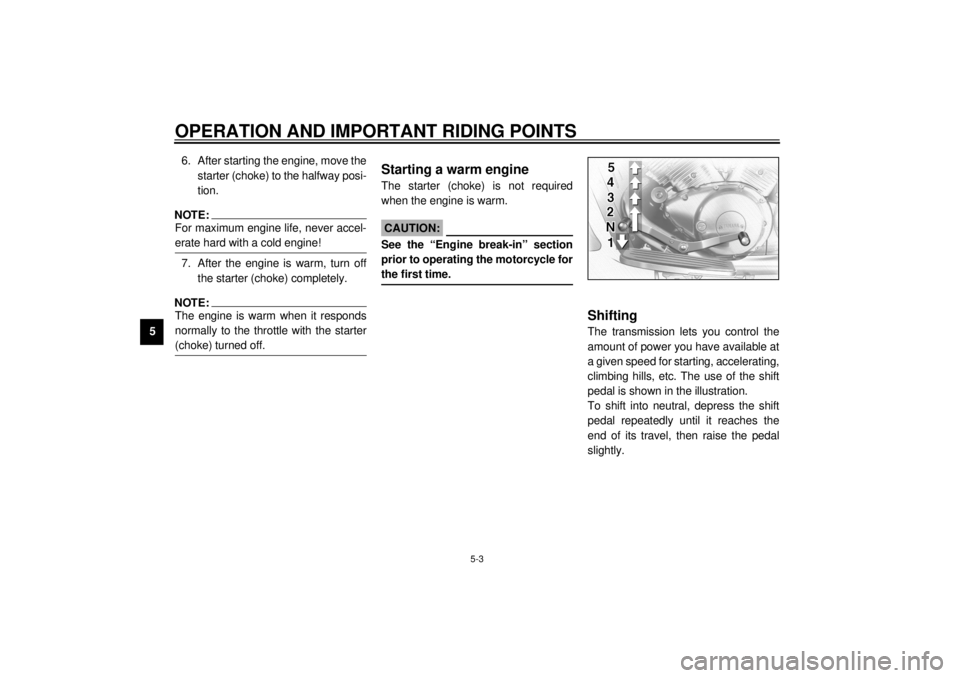
OPERATION AND IMPORTANT RIDING POINTS
5-3
56. After starting the engine, move the
starter (choke) to the halfway posi-
tion.
NOTE:@ For maximum engine life, never accel-
erate hard with a cold engine! @7. After the engine is warm, turn off
the starter (choke) completely.NOTE:@ The engine is warm when it responds
normally to the throttle with the starter
(choke) turned off. @
EAU01258
Starting a warm engineThe starter (choke) is not required
when the engine is warm.
EC000046
CAUTION:@ See the “Engine break-in” section
prior to operating the motorcycle for
the first time. @
EAU00423
ShiftingThe transmission lets you control the
amount of power you have available at
a given speed for starting, accelerating,
climbing hills, etc. The use of the shift
pedal is shown in the illustration.
To shift into neutral, depress the shift
pedal repeatedly until it reaches the
end of its travel, then raise the pedal
slightly.
E_4YP_Operation.fm Page 3 Wednesday, October 6, 1999 10:05 AM
Page 38 of 91

OPERATION AND IMPORTANT RIDING POINTS
5-4
5
EC000048
CAUTION:@ l
Do not coast for long periods
with the engine off, and do not
tow the motorcycle a long dis-
tance. Even with gears in neu-
tral, the transmission is only
properly lubricated when the
engine is running. Inadequate
lubrication may damage the
transmission.
l
Always use the clutch when
changing gears. The engine,
transmission, and driveline are
not designed to withstand the
shock of forced shifting and can
be damaged by shifting without
using the clutch.
@
EAU00424
Tips for reducing fuel
consumptionYour motorcycle’s fuel consumption
depends to a large extent on your
riding style. The following tips can help
reduce fuel consumption:l
Warm up the engine before riding.
l
Turn off the starter (choke) as
soon as possible.
l
Shift up swiftly and avoid high en-
gine speeds during acceleration.
l
Do not double-clutch or rev the en-
gine while shifting down and avoid
high engine speeds with no load
on the engine.
l
Turn off the engine instead of let-
ting it idle for an extended length
of time, i.e. in traffic jams, at traffic
lights or railroad crossings.
E_4YP_Operation.fm Page 4 Wednesday, October 6, 1999 10:05 AM
Page 39 of 91
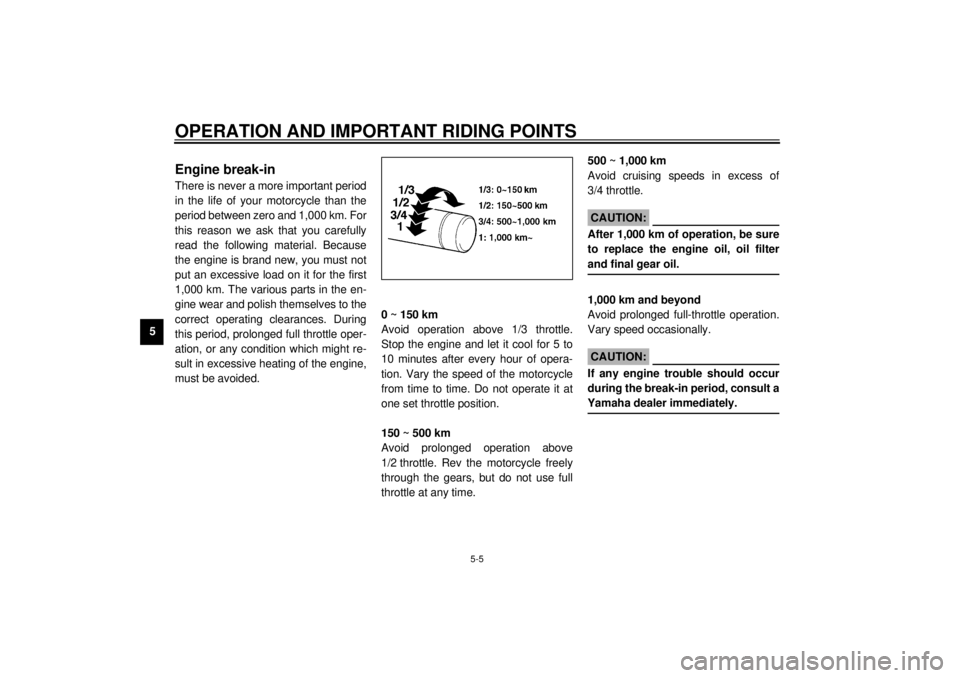
OPERATION AND IMPORTANT RIDING POINTS
5-5
5
EAU00436
Engine break-inThere is never a more important period
in the life of your motorcycle than the
period between zero and 1,000 km. For
this reason we ask that you carefully
read the following material. Because
the engine is brand new, you must not
put an excessive load on it for the first
1,000 km. The various parts in the en-
gine wear and polish themselves to the
correct operating clearances. During
this period, prolonged full throttle oper-
ation, or any condition which might re-
sult in excessive heating of the engine,
must be avoided.
EAU00444
0 ~ 150 km
Avoid operation above 1/3 throttle.
Stop the engine and let it cool for 5 to
10 minutes after every hour of opera-
tion. Vary the speed of the motorcycle
from time to time. Do not operate it at
one set throttle position.
150 ~ 500 km
Avoid prolonged operation above
1/2 throttle. Rev the motorcycle freely
through the gears, but do not use full
throttle at any time.500 ~ 1,000 km
Avoid cruising speeds in excess of
3/4 throttle.
EC000056
CAUTION:@ After 1,000 km of operation, be sure
to replace the engine oil, oil filter
and final gear oil. @1,000 km and beyond
Avoid prolonged full-throttle operation.
Vary speed occasionally.
EC000049
CAUTION:@ If any engine trouble should occur
during the break-in period, consult a
Yamaha dealer immediately. @
E_4YP_Operation.fm Page 5 Wednesday, October 6, 1999 10:05 AM
Page 40 of 91
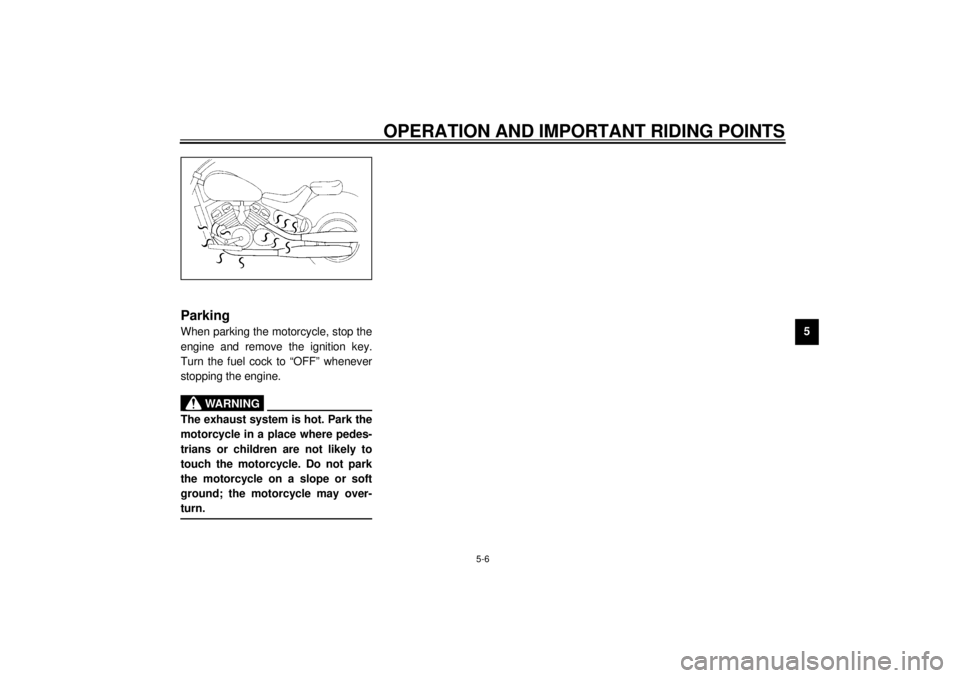
OPERATION AND IMPORTANT RIDING POINTS
5-6
5
EAU00457
ParkingWhen parking the motorcycle, stop the
engine and remove the ignition key.
Turn the fuel cock to “OFF” whenever
stopping the engine.
EW000058
WARNING
@ The exhaust system is hot. Park the
motorcycle in a place where pedes-
trians or children are not likely to
touch the motorcycle. Do not park
the motorcycle on a slope or soft
ground; the motorcycle may over-
turn. @
E_4YP_Operation.fm Page 6 Wednesday, October 6, 1999 10:05 AM